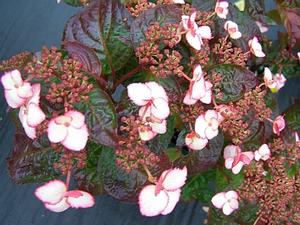View All Plants :: View All DECIDUOUS SHRUBS :: View All SHRUBS
Hydrangea serrata 'Fire on the Mountain'
Mountain Hydrangea
Plant Type:
DECIDUOUS SHRUBSHydrangea serrata 'Fire on the Mountain' - Beautiful new, glossy foliage is flushed in dark red-maroon and slowly infuses some green in the mix for an overall maroon-bronze appearance from afar. New leaves erupt very dark maroon wine and in sun the leaves tend to hold onto much of the depth of this color. The leaves erupt in fire in autumn again. Showy, light pink lace cap flowers in late spring last for many weeks in summer. They are simply beautiful atop the foil of dark red foliage. These are full sun tolerant given their soil is fertile and constantly moist. Indeed, we expect in more sun the foliage color will be even deeper, more glowering and last longer. Site it with a variegated cohort for drama and contrast. For gardeners towards the northern end of its range spring planting is advised. Established potted Mountain Hydrangea, cutting grown.
Characteristics and Attributes for Hydrangea serrata 'Fire on the Mountain'
Season of Interest (Flowering)
- Late Spring / Summer
Season of Interest (Foliage)
- Spring / Summer / Autumn
Autumn Interest
- Autumn Leaf Color
Nature Attraction
- Deer Resistant
Light
- Morning Sun / Afternoon Shade
- Mostly Sunny
- Full Sun
Attributes
- Border
- Foliage
- Specimen
- Accent
Growth Rate in the Garden
- Moderately Fast
Soil
- Organic
- Moist
- Fertile
- Humus Laden
- Draining
Origins
- Garden Origin
Propagated By
- Cutting Grown
Genus Overview: Hydrangea serrata
This species originates in the mountains of Japan and Korea. Though it is purportedly hardier than H. macrophylla we seldom see flowers in USDA zone 5b; as such we are listing all of the following cultivars as better doers in zones 6 to 9. The ovate to lanceolate foliage tends to be narrower than its close cousin, H. macrophylla. The smaller leaves support an over all more delicate appearance. And as with H. macrophylla there are also both lace caps and mop heads occurring in this species and will be noted below. We've seen this group also listed as H. macrophylla var. serrata. All prefer fertile soil to sandy loam. All of the following cultivars are cutting grown.


